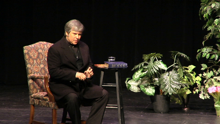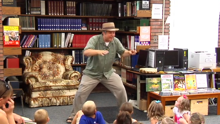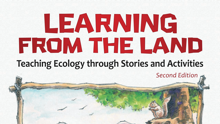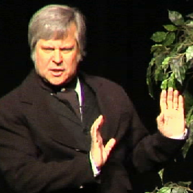Ecological Lessons from the Journals of Early Naturalists

The journals of early naturalists can lead to explorations in local natural history, serve as models for creative writing, and inspire students to conserve and restore the wild places that once existed.
by Brian “Fox” Ellis
Invite John James Audubon, to your school, conference, festival or museum.
What can we learn about our local natural history from the journals of early explorers and naturalists? How can students’ journals help them learn science process skills? In what ways can the journals of early naturalists inspire interdisciplinary lessons in art, history, literature, and natural history? These are some of the questions I have pondered as, for the past several years, I have portrayed John James Audubon at schools, nature centers, and museums.
John James Audubon (1785-1851) not only painted all of the known birds of North America — more than 450 species — but was also an avid writer who published 50 accounts of his travels and travails in the wildest places on the continent. He traveled most of eastern North America, from Newfoundland to New Orleans, and left a treasury of observations. He kept a daily journal with field notes, and later published the five-volume Ornithological Biography, a compendium of five- to ten-page “bird biographies” of all of the birds that he painted, along with 50 “Delineations of American Scenery and Manners.”
Audubon has inspired me as a traveler and journalist, largely due to his great archive of field notes and journal entries. I always wonder as I wander; What did this place look like 100 or 200 years ago? What kind of wildlife might I have seen before the impact of modern life? What would it have been like to camp here a long time ago? Because Audubon was both an artist and a scientist and had an eye for detail, his words and images transport one back to that time, recreating the ambience of the places he visited. His journals, written in the first half of the 19th century, immerse one in the wilderness as he saw it then. This passage is from his essay “The Prairie,” written in 1811 after a “march of long duration” through the endless grasslands of Illinois, where I now live:
The weather was fine; all around me was as fresh and blooming as if it had just issued from the bosom of Nature. Although well moccasined, I moved slowly along attracted by the brilliancy of the flowers, and the gambols of the fawns along their dams, to all appearance as thoughtless of danger as I felt myself.
My march was of long duration; I saw the sun sinking below the horizon long before I could perceive any appearance of woodland, and nothing in the shape of man had I met with that day. The track which I followed was only an old Indian trace and as darkness overshadowed the prairie I felt some desire to reach a copse in which I might lie down to rest.
The Night Hawks were skimming over and around me, attracted by the buzzing wings of beetles which form their food, and the distant howling of wolves gave me some hope that I should soon arrive at the skirts of some woodlands.
Although Illinois is still known as the Prairie State, to walk all day across endless Illinois prairie is unimaginable today. Only 0.01% of the virgin prairie remains; and while efforts to preserve what is left and, more importantly, to restore large tracts of prairie, appear to be succeeding, to envisage the prairie landscape as it was, we must rely on the writings of early explorers like Audubon.
The historic perspectives of early explorers and naturalists highlight the ways the landscape has changed over time and can inspire and inform students’ writing. Further, their journals can help students become better observers of the world around them. Journaling teaches thinking skills, science process skills, and the mental habits of asking good questions and looking for answers. Ideally, these historic essays, coupled with field ecology and journaling, can both motivate students to take action to improve their local environment and provide a foundation of hard science for such habitat improvement.
Lessons emerge from the past
What did your local ecosystem look like 100 to 200 years ago? If you could step back in time, what would you see? If you could step into the future, might you see the restoration of some of the natural splendor that once existed? What can you and your students do to begin to recreate a healthy ecosystem for the future?
 In my workshops for educators and students, I use the paintings and journals of Audubon to share his love for all things wild. And as I tour as Audubon, I always reread his journal observations about the areas in which I will be performing. In my presentations, I try to quote these observations, and then, without stepping out of character, challenge the audience to rediscover the hidden gems in their local environment and to do what they can to restore wild places for the other creatures who share them.
In my workshops for educators and students, I use the paintings and journals of Audubon to share his love for all things wild. And as I tour as Audubon, I always reread his journal observations about the areas in which I will be performing. In my presentations, I try to quote these observations, and then, without stepping out of character, challenge the audience to rediscover the hidden gems in their local environment and to do what they can to restore wild places for the other creatures who share them. Elements of these lessons can be easily adapted for almost any grade level from upper elementary through high school. The following steps outline a unit that begins with reading the journals of early explorers and naturalists in your region and leads toward taking action to enhance or restore a local natural area.
1. Research the journals of early explorers who may have lived or worked in your region.
2. Share these essays and stories with your students.
3. Arrange an outdoor adventure and teach students how to take good field notes.
4. Challenge students to write an essay, poem, or story about the plants and animals they observed, with an emphasis on the interdependence of these organisms.
5. Have students compare and contrast their observations with those of historical authors.
6. Encourage students to draw inspiration from this information to make a difference in their community.
2. Share these essays and stories with your students.
3. Arrange an outdoor adventure and teach students how to take good field notes.
4. Challenge students to write an essay, poem, or story about the plants and animals they observed, with an emphasis on the interdependence of these organisms.
5. Have students compare and contrast their observations with those of historical authors.
6. Encourage students to draw inspiration from this information to make a difference in their community.
Each of these steps are discussed in detail below.
Research the journals of early explorers
For teachers who live in the eastern half of North America, Audubon’s journals would be a great place to start researching journal entries that pertain to your area. If Audubon did not visit your area, other historical naturalists probably did and may have written eloquently about what they found. The journals of Henry David Thoreau offer a window into rural life and natural history in mid-19th century New England. William Bartram’s Travels is a classic account of the colonial period in the southeastern United States by one of the world’s best botanists. John Wesley Powell’s journals of his travels in the southern Rockies are often inspiring, especially the passages about his trip down the wild Colorado River. Lewis and Clark are arguably two of the finest natural history writers to travel through the west. Alexander Mackenzie, in his work for various fur-trading companies, was one of the first Europeans to explore the northern Rockies, Yukon, and Pacific coast. The French explorer Père (Jacques) Marquette wrote eloquently about the Great Lakes and the Mississippi watershed. Through her journals and books, Catherine Parr Traill documented the flora and fauna of Upper Canada (Ontario) in the mid-1800s. La Vérendrye and his sons, from the Trois-Rivières region of Québec, were among the first Europeans to explore the Canadian prairies and Rockies. Isabella Bird’s A Lady’ Life in the Rocky Mountains recounts her adventures touring the Colorado Rockies alone on horseback in 1873. John Muir’s writings about his travels in California and Alaska are undoubtedly some of the best natural history ever written.
Although not historical authors, Sigurd Olsen, Aldo Leopold, Gretel Ehrlich, Annie Dillard, Barry Lopez, Barbara Kingsolver, Rachel Carson, and John McPhee are writers that inspire high school students to write well.
Share essays and stories
Read aloud and discuss with your students a few excerpts from your favorite historical author on natural history. If possible, select passages describing landscapes that are familiar to you and your students. Before you read, encourage students to imagine the world through the eyes of this writer. After reading, ask students to describe what they saw as they listened. Invite them to share their impressions of that place today, if it is one that they have visited. They could also share with a partner their memory of some other wilderness that the passage you read stirs in them.
A few open-ended questions can stimulate discussion. For example, Audubon’s description of the prairie makes me curious: Do wolves inhabit Illinois today? Have you seen nighthawks hunt for beetles? How would you describe the relationship between nighthawk, beetle, and prairie? What season is the author describing and how do you know? How many miles do you think Audubon walked; how many miles could you walk in a day? Is it possible to walk all day today without seeing a tree? Where in North America might we find an endless prairie like the one Audubon described? Such questions model inquiry-based thinking strategies and help to highlight the ideas that you hope students will gain from these readings.
A more challenging, and therefore more exciting, option is to research the author, learn some of the material by heart, and give a costumed performance as that character. This is not as daunting as it may sound. When I perform as Audubon, I do not memorize long passages of his journals. I have read and reread so much of his writing that it emerges almost as if from him whenever I step into the character. With an old hat or some other simple prop and a change of voice, you can make the material come to life in a manner that reading aloud cannot. As an optional follow-up activity, have students develop costumes and scripts to use in performing the work of an historical author.
Go outdoors and take good notes
Whether for a hike around the school grounds or a week-long wilderness expedition, take your students outside! Simply sitting for an hour under the oldest tree out behind the school or walking around the block will help them begin to notice the diversity of insects, birds, small mammals, and plants in their environment. Visit the same place at different times and in different weather conditions. Of course, a week-long expedition to a remote wilderness location is guaranteed to inspire great writing, but you might be surprised at the results of a walk through an urban neighborhood. I once led a teachers’ workshop in downtown Detroit where the only piece of “wild” we could find was a one-meter-square hole in the pavement. In it were a dead tree; an amazing array of insects, mosses, and lichen; and an abandoned bird’s nest — enough to inspire the 20 or so teachers to write poetry and essays about the miracles found in small places. The microcosm of this hole in the pavement became a window into the macrocosm of Detroit’s natural history. Plan an adventure!
Observation is one of the most basic, and therefore most important, skills in science, writing, and art; and taking good notes on what one observes is the essence of journal and nature writing. Have students write down everything they notice. Encourage them to make field sketches — as Audubon did — of what they see and to label the parts. Ask them to describe their sketches. Encourage them to ask questions and look for answers: What is happening? Why? Challenge them to hypothesize about their observations: Why do they think this is doing that? Have students draw a line down the middle of a page and on one side write what they see, the observable facts, and on the other side write questions about those facts and then try to find answers to the questions.
Count things. For example, recently I went kayaking and counted 11 deer — 9 does and 2 bucks. I also saw 5 beavers, 2 otters, 2 belted kingfishers, 15 red-tailed hawks, 2 broad-winged hawks, and 1 immature bald eagle. As an isolated tally, my counts may not mean much, but over time such counts give scientists critical information about changes in species populations, ranges, and diversity. Otters did not inhabit the river ten years ago, but I saw two of them. Deer and beaver were completely eliminated in Illinois by the end of the 19th century, but, as my counts show, both have made great comebacks. This habit of observing, counting, and recording can be applied to real scientific research by having students participate in annual bird counts and frog counts, help chart migrations, and measure local diversity through a variety of online environmental monitoring projects.
Always have students note the time of day, weather conditions, temperature, wind direction and speed, phase of the moon, length of day, and any other observable environmental conditions. Thomas Jefferson impressed on Meriwether Lewis the importance of noting weather conditions, temperature, cloud cover, and what the plants and animals were doing in relation to the season. Jefferson himself kept elaborate notes for 30 years on the seasonal changes he observed at Monticello, his estate near Charlottesville, Virginia. The study of such periodic biological phenomena — phenology — helps us make connections between such things as day length and flowering cycles, when birds molt, migrations, hibernation, and other events.
Good notes are the basis of good writing.
Write an essay, poem, or story
Have your students turn their notes into works of prose or poetry in the style and tradition of the American nature writers. From Henry David Thoreau to Annie Dillard, Walt Whitman to Rachel Carson, the approach of these writers has been to use a personal narrative format to draw readers into the wild world. Their narratives blend a poetic appreciation of nature with hard science to stretch the bounds of creative non-fiction. They celebrate the natural world, while raising important issues about our bond to this world.
Using a personal narrative format, students can simply describe what they saw, did, and thought about the outdoor experience. In this way they can create insightful literature that explores their relationship with their local ecosystem. Allow students to write about other personal experiences that they have had outdoors. Watching a robin hunt for worms on the school grounds may have reminded them of a time they saw a territorial dispute between two robins in their backyard. This could lead to an essay about personal space and carrying capacity, about how urban environments challenge our sense of boundaries and create stress for the animals who share our backyards. A simple question that stimulates this kind of deep thinking is “What can we learn from this animal about being better humans?”
Sharing their stories with others will motivate students to revise and improve their work. It could also stimulate deeper contemplation of their observations. During the writing process, have students share rough drafts with a partner or small group. Later, encourage them to publish or otherwise share their stories with classmates, other classes, local newspapers, or magazines.
Compare past and present
Have students compare and contrast their observations with the perspectives of historical authors. John McPhee’s modern essay “Profiles: Travels in Georgia” is one of the best examples of this kind of writing. McPhee, who wrote for The New Yorker magazine, retraced the footsteps of William Bartram, a botanist who made some of the first scientific forays beyond the east coast of the United States. McPhee took with him a guide who worked for the Georgia Department of Natural Resources. Making constant references to what Bartram saw 200 years earlier, McPhee leads the reader back and forth through time to challenge us to rethink our relationship to our natural surroundings.
Whether this type of comparison is done on paper or as an oral debate or discussion, the overarching questions are these: How are things different today? How are they the same? What caused the changes? How can we play a role in a healthier future?
Make a difference
Reading the journals and researching the life stories of great naturalists can be inspiring and instructive. Encourage students to draw inspiration from these explorations to make a difference in their community. An important aspect of young people’s transition toward adulthood is the eternal internal struggle of hopelessness against empowerment. As teachers, we know that an individual can make a difference and that a class working together can have a global impact. Gently guiding students as they debate, allow them to generate ideas and a plan of action. Help them find the resources and professional contacts to make their plans a reality. Their plan could be as simple as creating a schoolyard habitat or planting native flowers at home, or as complex as initiating a neighborhood renewal project or raising funds and legislative support for a new nature preserve.
Late in his life, in a letter to a friend, Audubon observed sadly that he might be the last to see the vast wilderness of North America. Let’s do more than just hope that he was wrong; let’s do our part to empower our students to conserve and restore wild places for their children.
Brian “Fox” Ellis is a storyteller and naturalist who performs at schools and conferences throughout North America. He is the author of Learning from the Land: Teaching Ecology Through Stories and Activities. He lives in Peoria, Illinois.
Notes
-
Some of my favorite online research projects for students are Cornell Lab’s Project FeederWatch; Journey North, a migration-monitoring program; and the U.S. Geological Survey’s Frog Watch Program.
-
McPhee, John, “Profiles: Travels in Georgia,” The New Yorker 49 (April 28, 1973), pp. 44-46; reprinted in William L Howarth, ed., The John McPhee Reader (New York: Farrar, Strauss Giroux, 1976).









